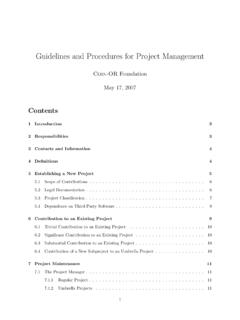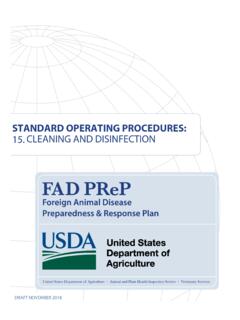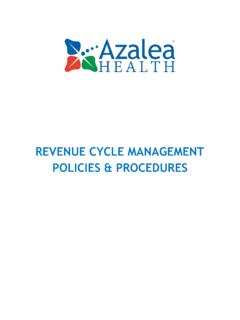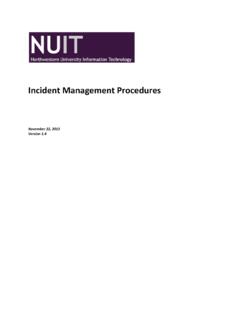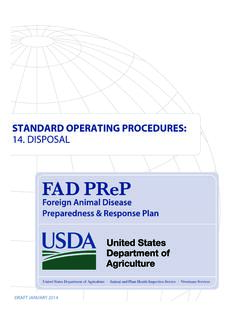Transcription of Practical steps for implementing policies and procedures
1 This is one in a series of information sheets addressing HIV/AIDS as an episodic disability in the workplace. 1. Benchmarking Organizational Policy Development and Implementation 2. A Rights Based Approach to Workplace Policy Development 3. HIV/AIDS and Human Rights in the Workplace 4. Discriminatory Business Practices 5. Privacy Protection in the Workplace 6. Employment Standards in the Workplace 7. Case Study Information Series 1 Preamble Identifying and upholding human rights, as it relates to employment, is strongly linked to how an organization demonstrates two key values: 1. Commitment to human rights in the workplace, and; 2. Respect and dignity for individuals managing a life threatening, chronic and/or episodic disability. When implementing human rights in the workplace, it is important to be aware that the steps taken at your organization will extend beyond policy and procedures development.
2 Policy development is a first step, policy implementation and how you bring the policy to life in your workplace is the next step. Employers are responsible for dealing effectively, quickly and fairly with situations involving claims of harassment and/or discrimination (which includes failure to accommodate employees needs). Employers could be held liable by a court or a human rights tribunal if they or responsible staff members do not act to end discrimination or harassment at their workplaces. We have been asked by workshop participants to identify some Practical steps that can be taken in the workplace to implement policies and uphold human rights. The following suggestions have been compiled from the feedback and recommendations we have received from individuals and organizations that have attended ICAD focus groups and the workshops held across Canada over the past year.
3 It also incorporates human resources recommended practices. For further information please refer to: , or contact your local Human Rights office. Introduction An organization s philosophy on human rights is reflected in both the workplace core values that have been established as well as in the policies and procedures that are developed and implemented. In order to increase awareness about human rights and non-discriminatory business practices, discussions should take place at all levels of the organization including, senior managers, supervisors, and all staff. Discussions about human rights with respect to employment and policy development may be driven by a number of factors and may include for example: Personal connection/experience with the issues Identifying and upholding human rights as a key organizational value Recruitment and retention Risk management and liability issues 8 Practical steps for implementing policies and procedures 1 Nicholas, Suite 726, Ottawa ON K1N 7B7 Telephone: (613) 233 7440 ?
4 Fax: (613) 233 8361 E- mail : ? Web: HIV/AIDS and the Workplace Information Sheets 9. HIV/AIDS and the Duty to Accommodate 10. Examples of Successful Job Accommodation 11. How to Use the Policy Template Package 12. Policy Template 13. Frequently Asked Questions 8. Practical steps for implementing policies and procedures 2 Costs of not developing and implementing a workplace policy Policy Development and Implementation There are a number of factors that should be taken into consideration when developing and implementing policies in the workplace. ICAD's policy package and sample policy template explain in detail how an organization can take a rights-based approach to policy development. To locate this resource information please refer to our website at The policy development stage is an opportunity to think about and/or discuss a number of factors related to policy implementation and the impact this will have at your organization.
5 Policy implementation refers to how an organization achieves a successful introduction to the policies it has developed and the Practical application or practices that follow. The first section in this resource document provides some considerations about the policy development stage. The second section provides Practical steps for policy implementation and upholding human rights in the workplace. Policy development should be tailored to respond to the organizational culture, operational requirements and available human and financial resources. Recruitment and retention of staff is linked directly to organizational policies , procedures and practices. When developing policies for HIV/AIDS and/or other episodic, life threatening or chronic illnesses, it provides an opportunity to identify, cross-reference and promote other relevant policies .
6 These may include, but are not limited to: Privacy and confidentiality Non-discrimination Anti-harassment Complaints and complaint resolution Job accommodation Flexible work arrangements Employment equity Health & safety Insurance benefits Gradual back to work programs New policies and/or revisions should provide information about the rationale behind it, how it relates to the mission or vision of the organization, how it links directly to human rights and employment and the complaint resolution process if applicable. To the extent possible, engage and involve staff in policy development discussions. Awareness raising and education = involvement. Where applicable, be sure to consult with unions and/or other workplace partners on policy development and implementation. Research and/or identify other successful policy models from your own network that can be adapted and applied to your workplace.
7 Organizational Considerations When implementing policy and procedures there are a number of considerations including the following: Visible support for the policy should be evident from the Board of Directors, Executive Director, Senior management Group or others as applicable. Core values that include a statement regarding human rights in the workplace should be identified. All employees should be concerned with developing a human rights culture in the workplace (Definition: A workplace environment where human rights and responsibilities are promoted and respected and Section 1: Fundamental Policy Development Considerations Section 2: Policy Implementation 3 where employees are free from concerns related to basic equity issues). All managers should be aware of their duties and responsibilities under human rights law and the related organizational policy.
8 Employees responsible for advice, policy adjudication and/or complaint resolution should receive specialized training. Plain language should be used for policy implementation information. All employees should have a copy of the policy or know where to access it for review. Employees should not be placed in the position of having to ask someone for the policy. Employees should sign off that they have received and reviewed the policy and agree to be bound by it. (Provide the acknowledgement form at the time of hiring or, at the latest, as part of the orientation process). The number of paper copies of the policy should be reduced/limited to avoid out-dated material from remaining in circulation. policies and procedures should be posted onto the shared intranet or other information sharing mechanisms that are available.
9 The policy should be communicated and promoted effectively and consistently. The policy should be discussed at staff meetings, department meetings and other meetings as applicable. The policy should be discussed with various committees as well as at the board as applicable (for example: health and safety committee, diversity and equity committee, personnel committee). All employees must be informed when the policy is up-dated to ensure that they understand the revisions, have an opportunity for questions and answers, sign off by acknowledging receipt and agree to be bound by the revised policy. The collective agreement and any revisions should be provided to all employees. The organization should plan to evaluate and measure the policy every two years reviewing the level of use, effectiveness, absenteeism rates, accessibility, privacy and confidentiality, perceptions and trust etc.
10 The organizational financial bottom line should be considered in combination with the human costs involved. Successful and supportive organizations understand the needs of the employee and the employer and how these can best be addressed for the benefit of all concerned. The organization should ensure respect and dignity in the workplace in order to make it a safe environment for employees to come forward to ask any questions they may have. Privacy and Confidentiality A key consideration for policy implementation is privacy and confidentiality. For example: Confidentiality and privacy is a priority at all times. Request that employees (especially those handling sensitive information) sign a confidentiality agreement. Identify one person responsible as the medical contact for the organization. For example, this contact may handle enquiries and/or information about the policy, accommodation in the workplace, discussions about next steps and insurance claims.





